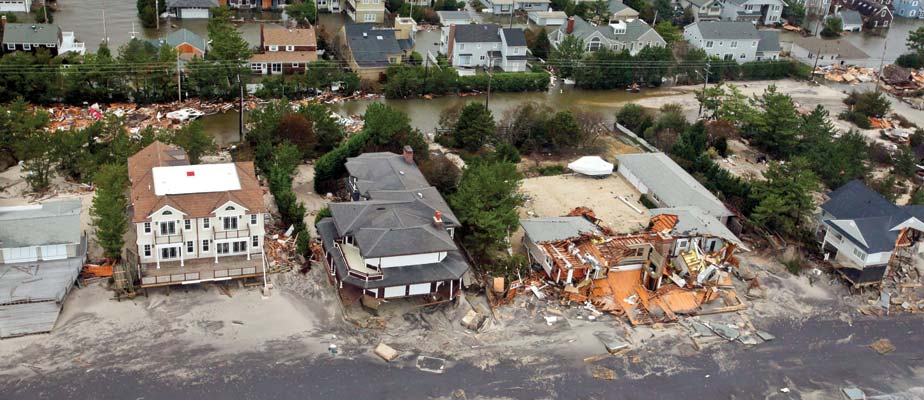Beyond Self

Aerial view of the damage caused by Hurricane Sandy taken during a search and rescue mission.
Surviving Sandy
Nazareth commits to relief and recovery for hurricane victims
by Robyn Rime
photograph by Master Sgt. Mark C. Olsen, U.S. Air Force
“White caps were going down 97th Street,” says Ellen Contopidis, Ph.D., assistant professor of inclusive childhood education. “My sister sat on the stairs of her house literally watching the water rise and wondering when she should start swimming.”
Contopidis’s sister, along with her mother and three other siblings, live in Howard Beach, Queens, an area hit hard by Hurricane Sandy, the superstorm that devastated portions of the Northeast last October. Unable to reach her family in the days after the storm (“cell phones didn’t work because there was no electricity to charge them”), Contopidis spent hours on Facebook, where news was shared as it became available. She learned her family was fine, but their damage was extensive: whole apartments destroyed, basements and ground floors flooded and gutted, cars lost.
And Nazareth stepped in to help. Colleagues in the School of Education donated money; the Nazareth College Faculty Fund chipped in extra cash; and Assistant Professor of Adolescent Education Brian Bailey ’01G, Ph.D., loaned a portable generator. “The response from this community was amazing,” says Contopidis. “My family kept saying, ‘But they don’t even know us.’”
“We all have a natural tendency to want to respond to such a disaster,” says Nuala Boyle, executive director of Nazareth’s Center for Civic Engagement. “The key is to do so in an intentional way.” In a damaged area with no power and restricted transportation, responding in person may deplete limited resources. Even Contopidis, who brought the loaned generator as well as propane tanks, heaters, and extension cords to her family, stayed at a sister’s home in New Jersey instead of in Howard Beach.
There are clear stages to disaster response, explains Boyle. “In response and relief, most efforts are directed at immediately minimizing the hazards created by a disaster, such as emergency services, restoration of crucial services, and meeting basic needs. Recovery efforts are those projects intended to return the community to pre-disaster norms or better: clean-up, long-term rebuilding, and community development.”
Nazareth’s response has included both immediate relief and long-term recovery, with many of those efforts coordinated by the Center for Civic Engagement.
In addition to help for Contopidis’s family, the College had within weeks conducted a blood drive through the Center for Spirituality, a longtime Red Cross partner; collected clothing donations in conjunction with the Seabreeze Volunteer Fire Department; and organized cleaning supplies donated to assist with mud removal and mold abatement.
Longer-term recovery efforts have also begun. Throughout spring 2013, the College will partner with state and national organizations trained in disaster response, such as the American Red Cross, the Federal Emergency Management Agency (FEMA), All Hands Volunteers, and others. During spring break, Nazareth will send 14 students, faculty, and staff to Staten Island for hurricane-related service projects. “Recovery is something college students can really help with,” explains Boyle. “We’re ready to supply students for recovery when these organizations are ready to deploy people without specific disaster relief training.”
Funding may be the most useful thing right now, Boyle adds. Professors of Art Lynn Duggan and Mitch Messina organized a sale of donated artwork in December that raised nearly $600 for the Mayor’s Fund to Advance New York City, a nonprofit organization assisting with hurricane relief and recovery. Sand: Aid’s sale of “breakfast bundles” was arranged by Rochester-area schoolchildren (including those of Jennie Schaff, Ph.D., assistant professor of language, literacy, and technology) and raised more than $8,000 for the fund. Victoria Valente ’14 coordinated a student benefit concert in November; Matthew Hoople ’13 is planning another concert for the spring and raising additional funds through a student button design contest and sales.
Meanwhile, storm survivors have begun the long, onerous task of rebuilding, and Nazareth will continue to be there to support them. “Sometimes your world stops,” Contopidis says, “and the real world goes on. At Nazareth, people take the time to stop with you.”
To assist in Hurricane Sandy recovery, go through the National Voluntary Organizations Active in Disaster members listed at nvoad.org. For more information, contact Nuala Boyle at nboyle5@naz.edu or at 585-389-2674.
Robyn Rime is the editor of Connections.